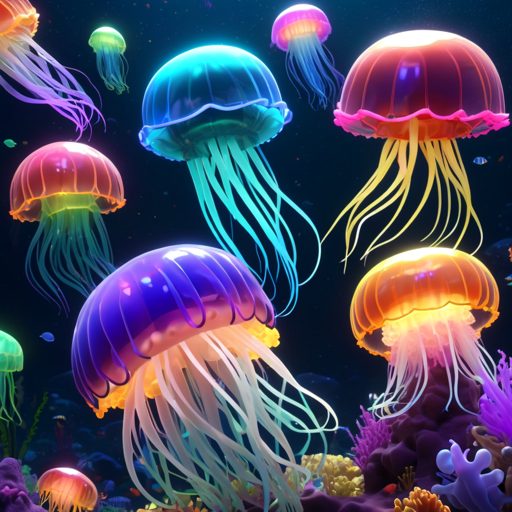The Bioluminescent Ballet: The Dazzling Displays of Comb Jellies
Imagine a world beneath the ocean’s surface where nature puts on a mesmerizing light show, captivating anyone fortunate enough to witness it. In this hidden realm, the stars are not in the sky but rather floating gracefully in the water. These celestial-like beings are none other than comb jellies, masters of the bioluminescent ballet that unfolds in the depths of our oceans.
A Symphony of Light in the Deep Blue
Under the cover of darkness, the ocean becomes a canvas for an otherworldly performance. Comb jellies, scientifically known as ctenophores, light up the water with a spectacular array of colors. Their bioluminescence is not a mere glow; it’s a dynamic display, a symphony of light orchestrated by these gelatinous creatures.
The Science Behind the Spectacle
Bioluminescence, the production and emission of light by living organisms, is a phenomenon that has intrigued scientists for centuries. In the case of comb jellies, this ethereal light serves various purposes. One of the primary reasons is for defense. When threatened, certain species of comb jellies release bursts of light, creating confusion for predators and allowing the jellies to escape.
The light is produced by specialized cells called photocytes, which contain light-emitting proteins. These proteins, such as aequorin and green fluorescent protein (GFP), are responsible for the vivid colors that make the bioluminescence of comb jellies so enchanting.
Variety in the Underwater Constellations
Just as our night sky boasts a variety of stars, comb jellies come in different species, each with its unique bioluminescent signature. Some emit a soft, pulsating glow, resembling a gentle dance of light, while others produce rapid flashes, creating a dynamic and vibrant underwater spectacle.
The diversity in their displays is not only visually captivating but also serves different purposes. Some species use their bioluminescence to attract prey, luring smaller organisms into their tentacle-lined mouths. Others use it for communication, creating intricate light patterns to signal and interact with fellow comb jellies.
The Role of Bioluminescence in Marine Ecology
Beyond the sheer aesthetic beauty, the bioluminescence of comb jellies plays a crucial role in the intricate web of marine ecology. These displays influence the behavior of other marine organisms, shaping the dynamics of the underwater world. For example, the flashing lights of comb jellies can attract larger predators, leading to a cascade effect that ripples through the entire ecosystem.
Understanding the role of bioluminescence in marine ecology is not only a testament to the wonders of nature but also holds potential applications in various fields, from medicine to technology. Researchers are exploring the unique properties of bioluminescent proteins found in comb jellies for their use in imaging techniques and even in the development of new drugs.
Conservation Challenges for the Comb Jellies
While these bioluminescent beings may seem like inhabitants of a magical realm, they face real-world challenges. Pollution, overfishing, and climate change pose threats to the delicate balance of the marine ecosystem, impacting the populations of comb jellies and their mesmerizing displays.
Conservation efforts are crucial to ensuring the continued existence of these ethereal creatures. By raising awareness about the importance of preserving their habitats and reducing human-induced stressors, we can contribute to the protection of the bioluminescent ballet that unfolds beneath the waves.
FAQs: Diving Deeper into the World of Comb Jellies
Q1: Are comb jellies the same as jellyfish?
No, comb jellies are not jellyfish. While they share a gelatinous appearance, they belong to different phyla. Comb jellies belong to the phylum Ctenophora, while jellyfish belong to the phylum Cnidaria. Unlike jellyfish, comb jellies lack stinging cells and instead use their sticky tentacles for capturing prey.
Q2: How does bioluminescence benefit comb jellies?
Bioluminescence serves various purposes for comb jellies. One primary benefit is defense, as the sudden bursts of light can confuse predators. Additionally, some species use bioluminescence to attract prey, while others employ it for communication with other comb jellies.
Q3: Can comb jellies be found in all oceans?
Yes, comb jellies are found in oceans worldwide, from the surface waters to the deep sea. They exhibit a broad distribution, and different species may inhabit various oceanic regions, contributing to the diversity of marine ecosystems.
In the enchanting world beneath the waves, comb jellies continue their bioluminescent ballet, a silent dance that adds a touch of magic to the mysteries of the ocean. As we strive to understand and appreciate these ethereal creatures, let us also work together to ensure the preservation of their fragile underwater realm.

